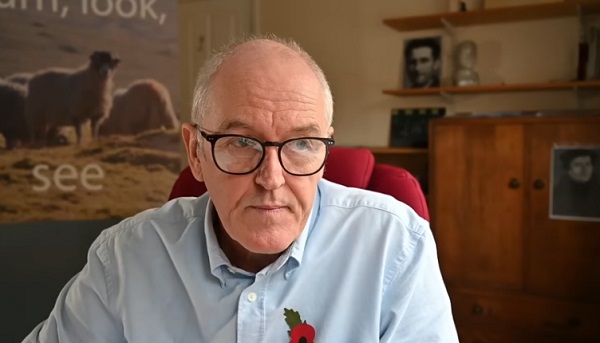Health
NEW STUDY: Infant Vaccine “Intensity” Strongly Predicts Autism Rates Worldwide

Across countries on three continents, a 1% increase in vaccine types before age one corresponded to a 0.47% increase in autism prevalence.
A new cross-national study from Italy’s National Research Council, spanning multiple developed countries across three continents, has identified a remarkably strong association between early-life vaccine intensity and autism prevalence. The number of vaccine types and doses administered before 12 months showed exceptionally high correlations with national autism rates.
A 1% increase in vaccine types before age one corresponded to a 0.47% increase in autism prevalence.
The correlation is enormous — r = 0.87 for vaccine types and r = 0.79 for vaccine doses. In regression models, vaccine intensity alone explained 81% of the variance in autism prevalence across nations.
This is not an isolated signal. It directly corroborates earlier U.S. state-level data from DeLong (2011) — and aligns with the 107 positive-association studies catalogued in the McCullough Foundation’s Landmark Autism Report.
Key Findings
Coccia used cross-national 2021 autism incidence data paired with WHO-reported infant vaccine schedules. Countries were grouped into relatively comparable healthcare and surveillance systems (North America, Europe, and advanced Asian nations) to reduce detection and reporting bias. The primary exposures were:
- number of vaccine types given ≤12 months, and
- total number of doses delivered ≤12 months.
Autism prevalence per 100,000 children served as the outcome, and general vaccination coverage rates were statistically controlled so only vaccine intensity and timing were isolated.
The results were striking but unfortunately expected:
- Countries such as the U.S., Canada, Australia, Japan, South Korea, and Singapore give ~15 vaccine types and 20 doses before age one — and have the highest autism prevalence (~1,273 per 100k).
- Countries like Norway, Finland, Denmark, Italy, and the UK give ~8 vaccine types and 9 doses — and have significantly lower autism rates (~834 per 100k).
- A 1% increase in vaccine types before age one corresponded to a 0.47% increase in autism prevalence.
- The regression model (log–log) explained 81% of the variance.
Coccia then used quadrant mapping to classify nations:
- Critical Risk Zone: high vaccine intensity + high autism (U.S., Canada, Australia, Japan, South Korea, Singapore)
- Protection Zone: low vaccine intensity + low autism (Nordic countries)
- Transitional Zone: countries on track to move upward as vaccine intensity rises (Italy, UK)
The conclusion is clear: Early-timed and compound vaccination strongly tracks with rising autism rates.
How DeLong (2011) Fits In
DeLong’s analysis of CDC data found that each 1% rise in U.S. childhood vaccination coverage was associated with ~680 additional cases of autism and speech/language impairment nationwide.
Where DeLong examined state-level associations between how many children were fully vaccinated and subsequent autism/SLI prevalence, Coccia provides the first true cross-national dose–response analysis — showing that the number of vaccine types and doses given before age one powerfully predicts national autism prevalence.
Both studies point in the same direction:
more vaccination in early life → higher autism prevalence.
How This Strengthens the McCullough Foundation’s Landmark Autism Report
Our Autism Report reviewed 136 vaccine-related studies:
- 107 studies inferred positive associations between vaccination or vaccine components and ASD/NDDs.
- All 12 vaccinated vs unvaccinated studies found better neurodevelopmental outcomes in completely unvaccinated children, including far lower rates of autism.
- Found strong, consistent increases in cumulative vaccine exposure during early childhood and the reported prevalence of autism across successive birth cohorts.
We concluded:
Combination and early-timed routine childhood vaccination constitutes the most significant modifiable risk factor for ASD, supported by convergent mechanistic, clinical, and epidemiologic findings, and characterized by intensified use, the clustering of multiple doses during critical neurodevelopmental windows, and the lack of research on the cumulative safety of the full pediatric schedule.
Coccia independently arrived at a highly similar conclusion:
This study offers a critical contribution to the ongoing discourse on vaccine safety and neurodevelopment by identifying a statistically significant association between early-life vaccine intensity and national autism rates.
All evidence points to the same conclusion:
Early, clustered vaccination is the strongest modifiable driver of rising autism rates.
Epidemiologist and Foundation Administrator, McCullough Foundation
Support our mission: mcculloughfnd.org
Please consider following both the McCullough Foundation and my personal account on X (formerly Twitter) for further content.
FOCAL POINTS (Courageous Discourse) is a reader-supported publication.
To receive new posts and support my work, consider becoming a free or paid subscriber.
Health
Lack of adequate health care pushing Canadians toward assisted suicide

From LifeSiteNews
The family of an elderly man is speaking out about the terrible hospital conditions that led their father to request euthanasia before he died of natural causes.
The family of Cleo Gratton, an 84-year-old retired diamond driller who died earlier this month in Chelmsford, Ontario, of natural causes after being approved for assisted suicide, is speaking publicly about their appalling experience in the Canadian healthcare system.
According to the CBC, the elderly man “told his family he would rather die than go back to Health Sciences North in Sudbury,” and that a recent stay there found Gratton, who was suffering from heart disease and kidney failure, spending one night in the emergency room and then being transferred to a bed sitting in the hallway on the seventh floor.
“There were no lights, all the bulbs in that hallway had been completely removed,” his daughter, Lynn, told the CBC. “The only light we had was almost like a desk lamp that had been bolted to the wall. Patients are passing by, nurses are going by, no privacy, no compassion, no dignity.” The visit took place in mid-October, after which Gratton decided to apply for “medical aid in dying,” or assisted suicide.
Lynn said that nurses had to use headlamps to inspect her father’s feet, and that the experience was “just one thing after another and it really opened our eyes to what’s going on in our hospitals. My dad said, ‘Push, push, push for change. Make people aware of what’s gong on. Open the discussion, bring it to your MP, your MPP, keep going straight up.”
His family is now honoring his wishes to speak out about his experience. The doctors and nurses, Lynn emphasized, were “amazing,” but she noted that they seem overworked. “Why are they still taking in patients if we have an overcrowding issue and they have no place to put these people?” she said.
Cleo Gratton, who died of natural causes surrounded by his family before he could go through with assisted suicide, is just the most recent of many examples of Canadians opting for assisted suicide because they could not access the care that they actually desired.
In Quebec last year, Norman Meunier, a quadriplegic man, developed bedsores after four days left on an ER stretcher without a good mattress. That experience combined with lack of available homecare pushed him to request, and receive, assisted suicide.
An unnamed woman in her 80s, referred to in a MAID report as “Mrs. B,” received MAID earlier this year after requesting but being denied palliative or hospice care. Instead, with her spouse burning out as the result of her care, a rushed MAID assessment was completed, and she died by lethal injection.
In 2022, 44-year-old Winnipeg woman Sathya Dhara Khovac died by euthanasia after failing to receive the homecare resources she had desperately sought. In her posthumous obituary, she said she could have had more time if she’d had more help.
In 2019, 41-year-old Sean Tagert was euthanized after spending years attempting to find and fund the homecare and resources he needed to stay in the community where his son lived. He did not want to die but felt that he had no other choice.
And, among other stories, at least four Canadian veterans were offered assisted suicide in lieu of the unavailable mental health supports they were requesting.
Stories of Canadians seeking palliative care, mental health resources, homecare, and other medical support finding that the only option available to them is assisted suicide have become routine over the past several years. Euthanasia has become a pressure valve for an overworked and under-funded healthcare system serving an aging population increasingly need of complex care — and if assisted suicide for mental illness is legalize, things will get much, much worse.
Dr John Campbell
Cures for Cancer? A new study shows incredible results from cheap generic drug Fenbendazole

From Dr. John Campbell
You won’t hear much about Fenbendazole from the regular pipeline of medical information. There could be many reasons for that. For one, it’s primarily known for it’s use in veterinary medicine. Somehow during COVID the medical information pipeline convinced millions that if a drug is used on horses or other animals it couldn’t work for humans. Not sure how they got away with that one considering the use of animal trials for much of modern medical history.
Another possible reason, one that makes at least as much sense, is that there’s no business case for Fenbendazole. It’s been around for decades and its patent expired in the early 1990’s. That means it’s considered a generic drug that a pharmaceutical company from India could (and does) produce in mass quantities for very little profit (compared to non-generics).
So Fenbendazole is an inexpensive, widely accessible antiparasitic drug used in veterinary medicine. During the COVID pandemic a number of doctors, desperate for a suitable treatment, tried it with reportedly great levels of success. Over some time they discovered it might be useful elsewhere. Some doctors are using Fenbendazole to help treat late stage cancer. Often this is prescribed when the regular treatments clearly aren’t working and cancer is approaching or has already been declared stage 4.
What they’ve found at least in some cases is astounding results. This has resulted in a new study which medical researcher Dr. John Campbell shares in this video.
-

 Artificial Intelligence2 days ago
Artificial Intelligence2 days agoAI seems fairly impressed by Pierre Poilievre’s ability to communicate
-

 Media2 days ago
Media2 days agoBreaking News: the public actually expects journalists to determine the truth of statements they report
-

 Alberta22 hours ago
Alberta22 hours agoCalgary mayor should retain ‘blanket rezoning’ for sake of Calgarian families
-

 Business2 days ago
Business2 days agoCarney doubles down on NET ZERO
-

 Business2 days ago
Business2 days agoLiberal’s green spending putting Canada on a road to ruin
-

 espionage1 day ago
espionage1 day agoTrump says release the Epstein files
-

 Bruce Dowbiggin21 hours ago
Bruce Dowbiggin21 hours agoSports 50/50 Draws: Make Sure You Read The Small Print
-

 COVID-1920 hours ago
COVID-1920 hours agoNew report warns Ottawa’s ‘nudge’ unit erodes democracy and public trust
















